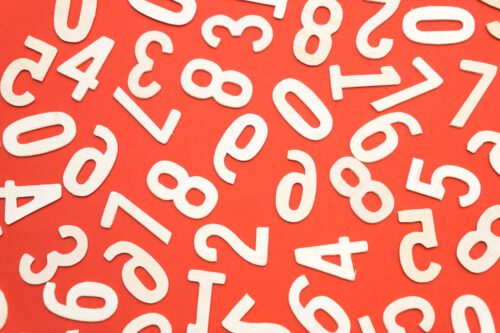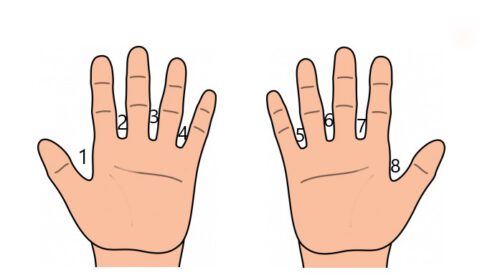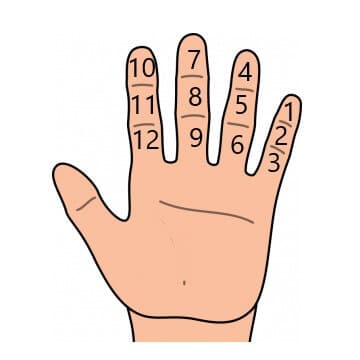Yoni wonders about the decimal system: "Is it human nature to count in cycles of 10?"

The decimal system seems to us to be self-evident from almost a part of nature. We are fascinated by round numbers. We arrange history by hundreds, life by decades, and only the prices are made sure to be as round as possible. And yet why did 10 win the premiere?
In the Khazari book, the poet and philosopher Yehuda Halevi used the universality of the base 10 as proof of the common origin of mankind from the first man of the book of Genesis "Of the number of the ten, every man in the east and in the west agreed upon him, what nature would he bring to the position of the ten?" But it is accepted from the beginning." NASA scientists were not convinced, and the information disc for aliens launched into space with the Voyager Beta spacecraft are grown in a binary base, thinking that the computer language based on 0 and 1 is the basis that every intelligent person in the universe will understand. The possibility that the recipients of the message will use quantum computers in which the "qubit" is not binary was not taken into account when the message was sent in 11110111001 (1977). Historical and anthropological research further undermines confidence in the naturalness or universality of base 10.
The decimal system as we know it was created in the Nile Valley and spread first to the Middle East and then to Asia and Europe. Anyone who wanted, like Jacob's sons for example, to trade with the empires had to adapt to base 10 and thus the alternatives disappeared. The most serious competitor to 10 was the dozen, such counting survived in Africa and India until the beginning of the 20th century, in northern Nigeria even a special word was recorded for the "thousand" of base 12 (12 to the 3rd power) called "our" 1728 system.
It is not difficult to find remnants of the decimal culture even thousands of years after the victory of the tenth: the day is divided into 24 hours - a reminder of the decimal division of the day. Hebrew and other languages have a special word for 12, and even a Google search reveals that "12" in its two English names (Twelve, dozen) has more occurrences than its neighbors 11 and 13. If it weren't for the victory of the Egyptian 10th over the dozen we would be celebrating the 60th Independence Day this year and the year would have been 1204
Some see the ten fingers as the natural arithmetic which gives an advantage to this basis and indeed counting with fingers is common among children at the beginning of arithmetic studies as well as among quite a few adults. But using the fingers does not require counting in base 10. The palms contain an 8 and a 12 calculator that are just as useful.


In addition, the feet also have fingers and counting in base 20 was common among the natives of South and Central America whose mathematical tradition was destroyed, along with other cultural assets, in the destruction that the decimal conquerors from Spain left, base 20 survived among the Inuit tribes (Eskimos) and even in modern French a memory of it is preserved in names The numbers between 80 and 99 (91 for example is Quatre vingt onze meaning four twenty eleven). Base 20 undermines another convention: it is possible to work simultaneously with more than one base. It seems that 20 names for digits are too many, therefore in these languages a base of 5 is common for small numbers so that the word for 17, for example, expresses 3 fifths plus 2. In many non-decimal societies, a counting method based on 2 and 5 was common (9 is 5+2+ 2) And the Roman numerals also preserve an ancient tradition of base 5 (4 is IV ie 5-1 while 6 is VI or 5+1)
Although Western culture received the decimal system from the great civilizations that preceded it, enclaves of non-decimal systems remained in it until the present day. The decimal system conquered the axis of natural numbers, but decimal fractions developed as the golden age of Arabic mathematics in the tenth century seeped very slowly into everyday life. The Jewish mathematician Emanuel Tov Elam wrote about their use in the 14th century, but European mathematicians began to deal with them only during the Renaissance. Writing a dot to separate the whole from the fraction was accepted only in the 17th century and mathematics textbooks did not include decimal fractions until the end of the 18th century. The lack of a convenient decimal system for fractions resulted in the preservation of non-decimal systems in coins and measures of length and weight. For example, the English pound was divided into 4 "crowns" and 20 shillings and 21 shillings, meaning 1.05 pounds were added to a guinea. In the USA, non-decimal measures of length and mass have survived to this day: 12 inches is a foot, three feet is a yard and 1,760 yards is a mile. It is interesting to note that the founding fathers: the first president Washington and Thomas Jefferson wanted to take advantage of the moment of grace of breaking away from the British Empire to transfer the young nation to a decimal measurement system. They succeeded in the area of currency (the dollar, unlike the pound, is divided into 100 cents) but Congress, most of whose members did not know the decimal point from their childhood textbooks, rejected their request. This is how the great power stuck until today with a system of weights and measures that preserves pre-decimal traditions.
What would our world look like if the powers didn't control base 10 over all of us?
Anthropologist Glendon Lean documented hundreds of counting methods in the last corners of the earth that survived globalization: in Papua and the islands of the Pacific Ocean. He did indeed find decimal tribes, most of them speaking Austronesian languages, a culture that washed over the area about 5,000 years ago, but alongside them a huge variety of counting and calculation methods: areas where base 5 ruled, mixed bases (especially 2,5 and 2,5.20) areas where the 6 Dominant as well as dozens of tribes that preceded the computer age and used base 2 (binary).
Lin thus mapped Papua and its surroundings and reconstructed its mathematical history. Counting using body parts is the earliest and was relegated to remote areas when base 2 methods were created which on their side lost the battle to bases 5 and 6 before the decimal invasion. But what is particularly surprising are tribes that manage without names for numbers and express quantitative information through body parts. Each finger is assigned a number, to pronounce 6 the speaker points to the center of the palm, 7 is the wrist, 8 is halfway to the elbow and so on. There are tribes that this method brings them to 18 in the face area and the Yupno tribe brings the count up to 33 when a variety of organs are used - for example 21 is the left ear and 32 is the right testicle. However, these methods are not endless, the sons of Yofna count, as mentioned, up to 33 on their bodies, so it will be difficult to explain to Ben Yofna how many ministers currently serve in the government of Israel (it is hoped that the tribe will overcome the lack of this item of information). It is possible, it turns out, to give up names for large numbers and counting bases in general.
Did an interesting, intriguing, strange, delusional or funny question occur to you? Send to ysorek@gmail.com
More of the topic in Hayadan:

7 תגובות
So how does a testicleless woman from the Yofano tribe count? *annoyed emoji*
In addition to Hagai's response
The ancient Mesopotamians also defined the degree according to base 60, 360 degrees is perfectly divisible by base 60 because 60 is a divisor of 360 and is itself full of divisors.
10 is a disgusting number and it would be good if we used 12.
Tell them Yopono that there are 10 ministers, he will understand.
Because it's the most convenient. and better this way. And really gets along well with ten fingers.
And fingers also have thumbs so it's base 14
How of all the counting methods did you skip the most important method of the ancient world - base 60 of the Mesopotamians. This system dominated the space longer than the existence of the decimal system.
Somehow you put base 12 in Africa, but forgot base 60?
No guys, these are not the Africans who divided the day into 24 hours, but it is a product of the Mesopotamian system (60 is divided by 12, 10, 6, 5, 4, 3, 2 and that's exactly how they used it. Their weights, for example, included multiples of 1, 2, 4, 8, sometimes 12, 16, 24, 32, 36, 40, 48, 60 and in different methods that drew from this method also 50, 42, 28, 6 and 5).
The French Revolution is very important for this matter. Instead of defining the nautical mile according to the division of the circumference of the earth into 360 degrees, 60 minutes of arc in each degree, that is, the nautical mile is a minute of arc on the earth (convenient for navigation), the French decided to divide the circle into 400 degrees, for each degree 100 minutes of arc in each minute Arc 100 seconds arc. In this calculation, every second of French arc is 10 meters. Divide by 10 which will be a convenient measure to use. To this day there are measuring devices that measure degrees in these units, called GRAD instead of DEGREE as in the previous method.
The French also built a time system with 20 hours in a day, 100 minutes in an hour and 100 seconds in a minute. The Museum of Islam in Jerusalem has such clocks. Just didn't catch it.
On what basis is Methuselah's age calculated?